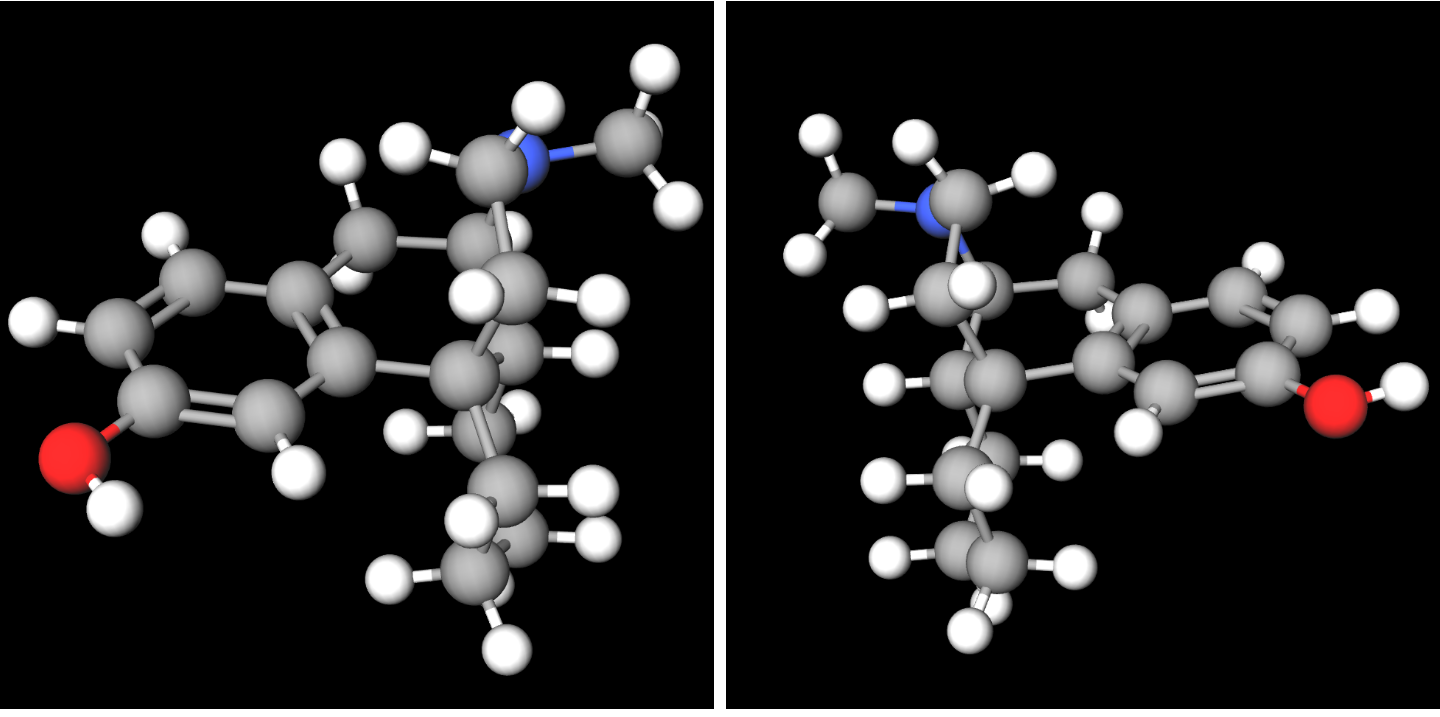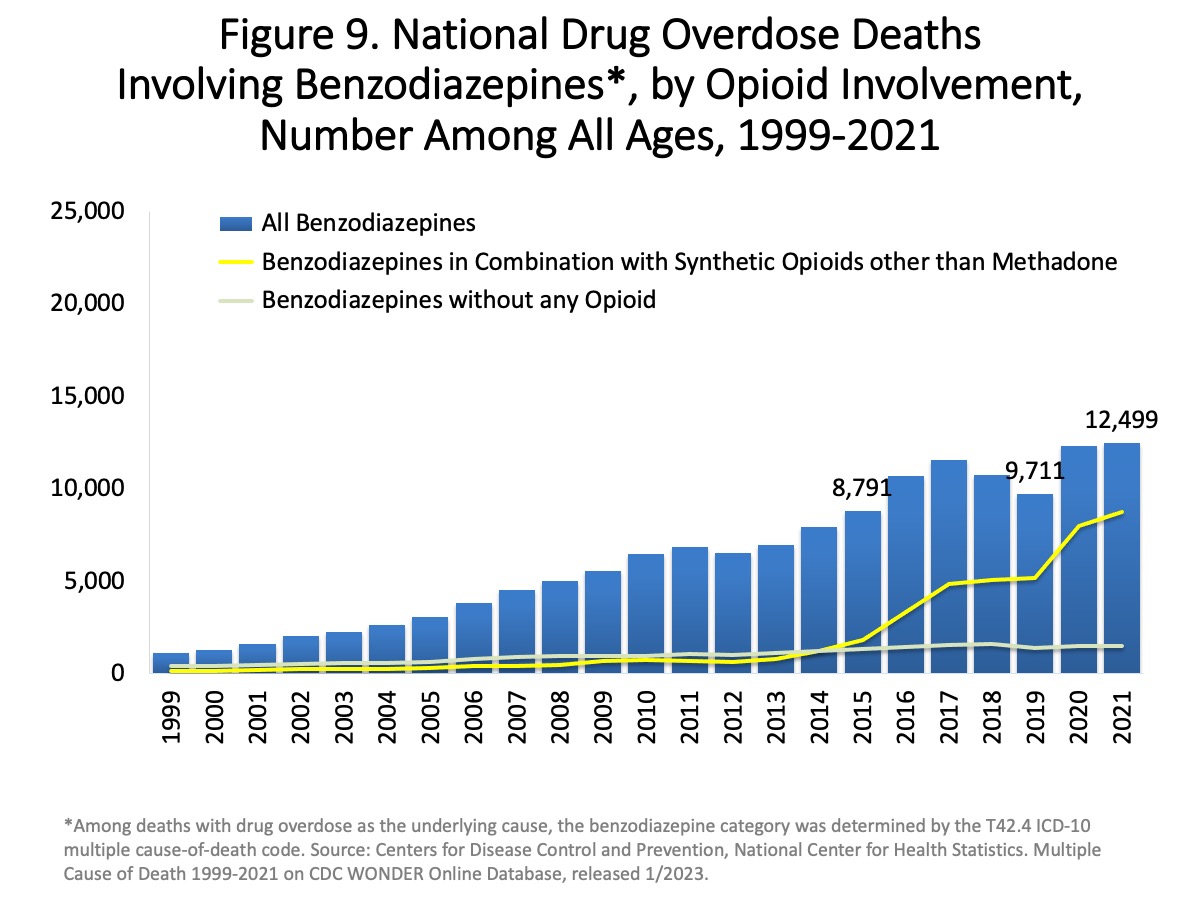|
Levorphanol
Levorphanol (brand name Levo-Dromoran) is an opioid medication used to treat moderate to severe pain. It is the levorotatory enantiomer of the compound racemorphan. Its dextrorotatory counterpart is dextrorphan. It was first described in Germany in 1946. The drug has been in medical use in the United States since 1953. Pharmacology Levorphanol acts predominantly as an agonist of the μ-opioid receptor (MOR), but is also an agonist of the δ-opioid receptor (DOR), κ-opioid receptor (KOR), and the nociceptin receptor (NOP), as well as an NMDA receptor antagonist and a serotonin-norepinephrine reuptake inhibitor (SNRI). Levorphanol, similarly to certain other opioids, also acts as a glycine receptor antagonist and GABA receptor antagonist at very high concentrations. Levorphanol is 6 to 8 times as potent as morphine at the MOR. Relative to morphine, levorphanol lacks complete cross-tolerance and possesses greater intrinsic activity at the MOR. The duration of action ... [...More Info...] [...Related Items...] OR: [Wikipedia] [Google] [Baidu] |
Opioid
Opioids are substances that act on opioid receptors to produce morphine-like effects. Medically they are primarily used for pain relief, including anesthesia. Other medical uses include suppression of diarrhea, replacement therapy for opioid use disorder, reversing opioid overdose, and suppressing cough. Extremely potent opioids such as carfentanil are approved only for veterinary use. Opioids are also frequently used non-medically for their euphoric effects or to prevent withdrawal. Opioids can cause death and have been used for executions in the United States. Side effects of opioids may include itchiness, sedation, nausea, respiratory depression, constipation, and euphoria. Long-term use can cause tolerance, meaning that increased doses are required to achieve the same effect, and physical dependence, meaning that abruptly discontinuing the drug leads to unpleasant withdrawal symptoms. The euphoria attracts recreational use, and frequent, escalating recreational ... [...More Info...] [...Related Items...] OR: [Wikipedia] [Google] [Baidu] |
Racemorphan
Racemorphan, or morphanol, is the racemic mixture of the two stereoisomers of 17-methylmorphinan-3-ol, each with differing pharmacology and effects: * Dextrorphan - an antitussive and dissociative hallucinogen (NMDA receptor antagonist) * Levorphanol - an opioid analgesic Racemorphan itself is under international control per the Single Convention on Narcotic Drugs 1961 and is therefore listed as a Schedule II Narcotic controlled substance in the US Controlled Substances Act 1970; it has an ACSCN of 9733 and in 2014 it had an aggregate annual manufacturing quota of zero. The salts in use are hydrobromide (free base conversion ratio 0.741), hydrochloride (0.876), and tartrate (0.632). See also * Levallorphan * Methorphan * Morphinan * Cyclorphan See also * Cough syrup * Noscapine * Codeine; Pholcodine * Dextromethorphan; Dimemorfan * Dextrorphan; Levorphanol * Butamirate Butamirate (or brospamin, trade names Acodeen, Codesin, Pertix, Sinecod, Sinecoden, Sinecodix) i ... [...More Info...] [...Related Items...] OR: [Wikipedia] [Google] [Baidu] |
Dextrorphan
Dextrorphan (DXO) is a psychoactive drug of the morphinan class which acts as an antitussive or cough suppressant and dissociative hallucinogen. It is the dextrorotatory enantiomer of racemorphan; the levorotatory enantiomer is levorphanol. Dextrorphan is produced by O-demethylation of dextromethorphan by CYP2D6. Dextrorphan is an NMDA antagonist and contributes to the psychoactive effects of dextromethorphan. Pharmacology Pharmacodynamics The pharmacology of dextrorphan is similar to that of dextromethorphan (DXM). However, dextrorphan is much more potent as an NMDA receptor antagonist as well much less active as a serotonin reuptake inhibitor, but retains DXM's activity as a norepinephrine reuptake inhibitor. It also has more affinity for the opiod receptors than dextromethorphan, significantly so at high doses. Pharmacokinetics Dextrorphan has a notably longer elimination half-life than its parent compound, and therefore has a tendency to accumulate in the blood after r ... [...More Info...] [...Related Items...] OR: [Wikipedia] [Google] [Baidu] |
κ-opioid Receptor
The κ-opioid receptor or kappa opioid receptor, abbreviated KOR or KOP, is a G protein-coupled receptor that in humans is encoded by the ''OPRK1'' gene. The KOR is coupled to the G protein Gi/G0 and is one of four related receptors that bind opioid-like compounds in the brain and are responsible for mediating the effects of these compounds. These effects include altering nociception, consciousness, motor control, and mood. Dysregulation of this receptor system has been implicated in alcohol and drug addiction. The KOR is a type of opioid receptor that binds the opioid peptide dynorphin as the primary endogenous ligand (substrate naturally occurring in the body). In addition to dynorphin, a variety of natural alkaloids, terpenes and synthetic ligands bind to the receptor. The KOR may provide a natural addiction control mechanism, and therefore, drugs that target this receptor may have therapeutic potential in the treatment of addiction. There is evidence that distribution ... [...More Info...] [...Related Items...] OR: [Wikipedia] [Google] [Baidu] |
Psychotomimetic
A drug with psychotomimetic (also known as psychotogenic) actions mimics the symptoms of psychosis, including delusions and/or delirium, as opposed to only hallucinations. Psychotomimesis is the onset of psychotic symptoms following the administration of such a drug. Some rarely used drugs of the opioid class have psychotomimetic effects. Particularly, mixed kappa receptor agonist mu receptor antagonist opioid analgesics can cause dose-related psychotomimesis. This adverse effect, incidence 1–2%, limits their use. Pentazocine and butorphanol fall under this opioid class. There is evidence that cannabinoids are psychotomimetic, especially delta-9-tetrahydrocannabinol (Δ9-THC). D'Souza et al. (2004) found that intravenous THC produced effects that resemble schizophrenia in both the positive symptoms (hallucinations, delusions, paranoia, and disorganized thinking) and negative symptoms ( avolition, asociality, apathy, alogia, and anhedonia). Certain strains of cannabis may be ... [...More Info...] [...Related Items...] OR: [Wikipedia] [Google] [Baidu] |
Norepinephrine Transporter
The norepinephrine transporter (NET), also known as noradrenaline transporter (NAT), is a protein that in humans is encoded by the solute carrier family 6 member 2 (SLC6A2) gene. NET is a monoamine transporter and is responsible for the sodium-chloride (Na+/Cl−)-dependent reuptake of extracellular norepinephrine (NE), which is also known as noradrenaline. NET can also reuptake extracellular dopamine (DA). The reuptake of these two neurotransmitters is essential in regulating concentrations in the synaptic cleft. NETs, along with the other monoamine transporters, are the targets of many antidepressants and recreational drugs. In addition, an overabundance of NET is associated with ADHD. There is evidence that single-nucleotide polymorphisms in the NET gene (''SLC6A2'') may be an underlying factor in some of these disorders. Gene The norepinephrine transporter gene, SLC6A2 is located on human chromosome 16 locus 16q12.2. This gene is encoded by 14 exons. Based on the nucleotide ... [...More Info...] [...Related Items...] OR: [Wikipedia] [Google] [Baidu] |
Serotonin Transporter
The serotonin transporter (SERT or 5-HTT) also known as the sodium-dependent serotonin transporter and solute carrier family 6 member 4 is a protein that in humans is encoded by the SLC6A4 gene. SERT is a type of monoamine transporter protein that transports the neurotransmitter serotonin from the synaptic cleft back to the presynaptic neuron, in a process known as serotonin reuptake. This transport of serotonin by the SERT protein terminates the action of serotonin and recycles it in a sodium-dependent manner. Many antidepressant medications of the SSRI and tricyclic antidepressant classes work by binding to SERT and thus reducing serotonin reuptake. It is a member of the sodium:neurotransmitter symporter family. A repeat length polymorphism in the promoter of this gene has been shown to affect the rate of serotonin uptake and may play a role in sudden infant death syndrome, aggressive behavior in Alzheimer disease patients, post-traumatic stress disorder and depression-susc ... [...More Info...] [...Related Items...] OR: [Wikipedia] [Google] [Baidu] |
Tramadol
Tramadol, sold under the brand name Ultram among others, is an opioid pain medication used to treat moderate to moderately severe pain. When taken by mouth in an immediate-release formulation, the onset of pain relief usually begins within an hour. It is also available by injection. It is available in combination with paracetamol (acetaminophen). As is typical of opioids, common side effects include constipation, itchiness, and nausea. Serious side effects may include hallucinations, seizures, increased risk of serotonin syndrome, decreased alertness, and drug addiction. A change in dosage may be recommended in those with kidney or liver problems. It is not recommended in those who are at risk of suicide or in those who are pregnant. While not recommended in women who are breastfeeding, those who take a single dose should not generally stop breastfeeding. Tramadol is converted in the liver to ''O''-desmethyltramadol (desmetramadol), an opioid with a stronger affinity to the � ... [...More Info...] [...Related Items...] OR: [Wikipedia] [Google] [Baidu] |
Cross-tolerance
Cross-tolerance is a phenomenon that occurs when tolerance to the effects of a certain drug produces tolerance to another drug. It often happens between two drugs with similar functions or effects—for example, acting on the same cell receptor or affecting the transmission of certain neurotransmitters. Cross-tolerance has been observed with pharmaceutical drugs such as anti-anxiety agents and illicit substances, and sometimes the two of them together. Often, a person who uses one drug can be tolerant to a drug that has a completely different function.Kolb, Bryan, and Ian Whishaw. An Introduction to Brain and Behavior. New York: Worth Publishers, 2014. Print. This phenomenon allows one to become tolerant to a drug that they have never used before. Drug classifications and cross-tolerance Anxiolytics and sedatives Excitation of the GABA receptor produces an influx of negatively charged chloride ions, which hyperpolarizes the neuron and makes it less likely to give rise to an a ... [...More Info...] [...Related Items...] OR: [Wikipedia] [Google] [Baidu] |
Ketobemidone
Ketobemidone, sold under the brand name Ketogan among others, is a powerful synthetic opioid painkiller. Its effectiveness against pain is in the same range as morphine, and it also has some NMDA-antagonist properties imparted, in part, by its metabolite norketobemidone. This may make it useful for some types of pain that do not respond well to other opioids. It is marketed in Denmark, Iceland, Norway and Sweden and is used for severe pain. History Ketobemidone was first synthesized in 1942 by Eisleb and colleagues, at the laboratory of I.G. Farbenindustrie at Hoechst during the Second World War. The first study of it in humans was published in 1946, and it was introduced in clinical medicine shortly after. It was not in clinical use in the United States when the Controlled Substances Act 1970 was promulgated and was assigned to Schedule I with an ACSCN of 9628. As of 2013, no annual manufacturing quota was assigned by the DEA. Pfizer manufactures ketobemidone under the ... [...More Info...] [...Related Items...] OR: [Wikipedia] [Google] [Baidu] |
Phenylpiperidine
Phenylpiperidines are chemical compounds with a phenyl moiety directly attached to piperidine. There are a variety of pharmacological effects associated with phenylpiperidines including morphine-like activity or other central nervous system effects. Methylphenidate is a ''benzyl In organic chemistry, benzyl is the substituent or molecular fragment possessing the structure . Benzyl features a benzene ring () attached to a methylene group () group. Nomenclature In IUPAC nomenclature, the prefix benzyl refers to a subst ...''piperidine. References Piperidines {{heterocyclic-stub ... [...More Info...] [...Related Items...] OR: [Wikipedia] [Google] [Baidu] |
Methadone
Methadone, sold under the brand names Dolophine and Methadose among others, is a synthetic opioid agonist used for chronic pain and also for opioid dependence. It is used to treat chronic pain, and it is also used to treat addiction to heroin or other opioids. Prescribed for daily use, the medicine relieves cravings and removes withdrawal symptoms. Detoxification using methadone can be accomplished in less than a month, or it may be done gradually over as long as six months. While a single dose has a rapid effect, maximum effect can take up to five days of use. The pain-relieving effects last about six hours after a single dose. After long-term use, in people with normal liver function, effects last 8 to 36 hours. Methadone is usually taken by mouth and rarely by injection into a muscle or vein. Side effects are similar to those of other opioids. These frequently include dizziness, sleepiness, vomiting, and sweating. Serious risks include opioid abuse and respiratory dep ... [...More Info...] [...Related Items...] OR: [Wikipedia] [Google] [Baidu] |




